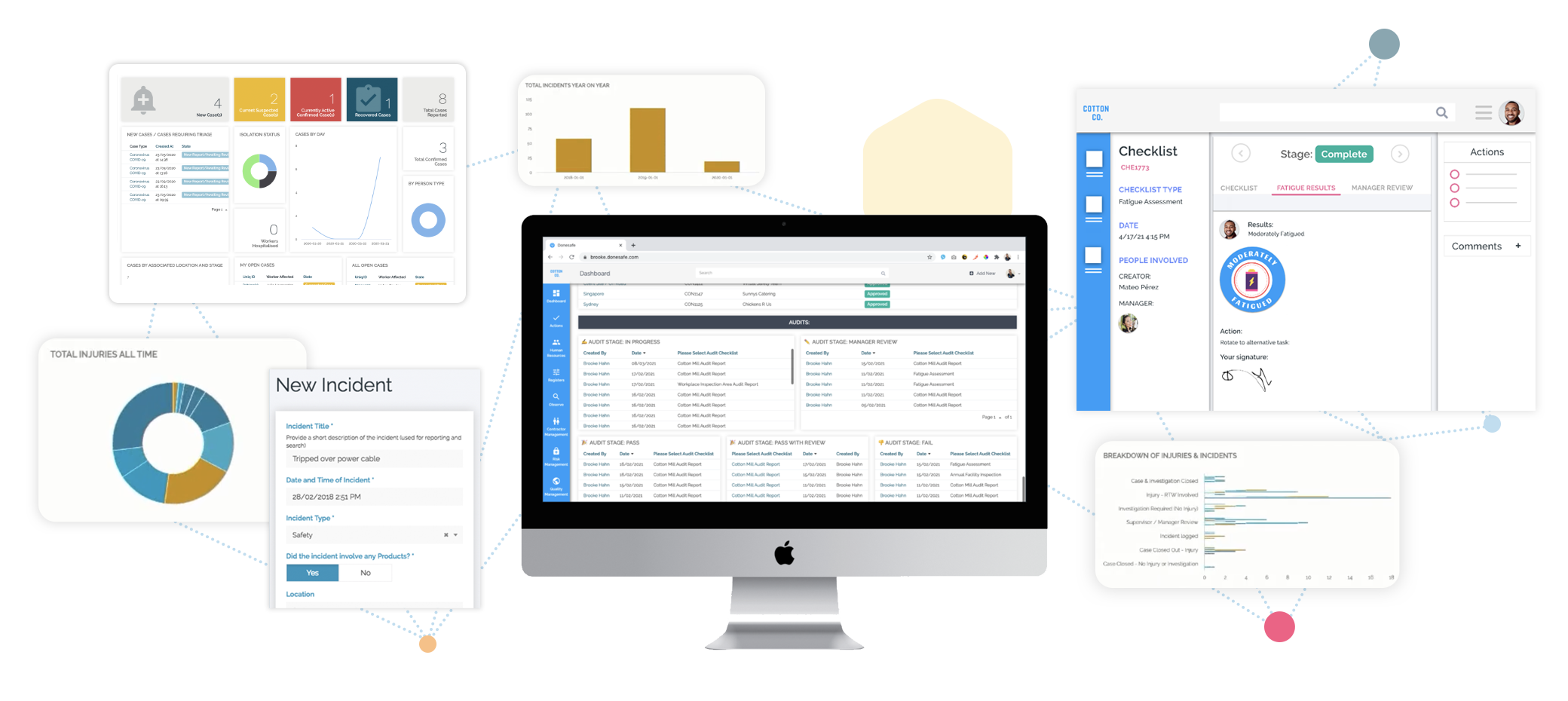Today’s modern workplaces are dynamic and adapting constantly. EHS systems need to not only keep up with tomorrow’s workplace needs but become the fabric of the unified workplace. Discover universal EHS technology.




What is an EHS management system?
EHS (Environmental, Health, and Safety) management systems are solutions used to streamline the implementation of corporate EHS objectives.
Investing in a cloud EHS system can result in decreased risk exposure, improved safety performance, increased efficiency, and cost savings in EHS resource use.
Cloud EHS systems allow businesses to access data from anywhere, automatically capture documents from remote sites, connect global teams to share information quickly and securely, and create custom EHS insights generated from powerful analytics capabilities. Some of the key areas an EHS system covers include hazard mitigation, compliance and regulation audits, and tracking hazardous materials.
Some of the most popular EHS systems use cases are:
- Hazard Management
- Incident Management
- Checklists & Inspections
- Audit Management
- Contractor Management
- Asset Management
- Quality Management
- Environmental Management
- Chemical Management
- Learning Management
Discover all 50+ EHS modules with HSI Donesafe
See All Modules
 Meet Compliance
Meet Compliance
- Align with legal, regulatory & government obligations.
- Meet ISO, OSHA, OHS, WHS & other standards.
- Become audit-ready with complete audit trails.
 Manage Risk
Manage Risk
- De-risk the workplace with proactive risk management.
- Incorporate risk frameworks into investigations and assessments.
- Actively manage risk with risk scoring, risk matrices, and robust risk controls.
 Centralize Process
Centralize Process
- Bring data collection and document management to a single centralized system.
- Streamline complex, disjointed workflows under one system.
- Manage user profiles, actions, permissions & process controls in one place.
 Improve Visibility
Improve Visibility
- Track, monitor, and gather insights using real-time dashboards & analytics.
- Make smarter decisions faster with data insights surfaced instantly via alerts, and notifications.
- Run advanced reporting for deeper insights and data mining utilizing business intelligence (BI) capabilities.
 Drive Productivity
Drive Productivity
- Drive workforce efficiencies with cloud-based EHS technology accessible anywhere, even in offline environments.
- Seamless digital workflows eliminate clunky paper-based, manual spreadsheets and other cumbersome systems.
- Lower admin overheads with automation, reminders & follow-ups to drive task completion.
Ready to discover the next-gen universal EHS system?
Over 3 million+ global users from billion-dollar companies trust HSI Donesafe to keep their workplaces compliant, safe & sustainable with next-gen cloud technology.
What does an EHS management system cover?
Environment
Manage environmental incidents, hazards, risks & sustainability KPIs to ensure environmental impact is minimized proactively while having a system in place to manage environmental events.
Health
Manage employee well-being, injuries, illness, and mental health of the workforce by capturing, tracking, and taking action on hazards, psychosocial risks, and injuries.
Safety
Manage workplace safety when it comes to people, assets, and the environment from capturing unsafe behaviors, hazards, and incidents, to actively managing safety processes and policies.
What are some of the different types of systems and software
There are many related EHS systems and software acronyms that largely refer to the same technology or capabilities of EHS management systems. Below is a summary of the various types of EHS systems and their focus areas.
SMS
A Safety Management System (SMS) is a structured and proactive approach to managing safety, including identifying hazards and implementing controls to mitigate risks in order to ensure the safety of personnel, equipment, and the environment.
Explore SMS SystemsEHS
An Environmental, Health, and Safety (EHS) system is a framework that organizations use to manage and continuously improve their environmental, health, and safety performance, in order to protect their employees, the public, and the environment.
Explore EHS SoftwareEHSQ
An Environment, Health, Safety and Quality (EHSQ) system is a comprehensive and integrated approach to managing an organization’s environmental, health, safety, and quality risks and opportunities, with the aim of ensuring sustainability and enhancing overall performance.
Explore EHSQ SystemsWHS
A Workplace Health and Safety (WHS) system is a set of policies, procedures, and practices that an organization implements to ensure the health, safety, and welfare of its employees, visitors, and other stakeholders while complying with relevant laws and regulations.
Explore WHS SystemsOHS
An Occupational Health and Safety (OHS) system is a management system that helps organizations proactively manage their occupational health and safety risks and obligations, with the aim of creating a safe and healthy workplace for employees and reducing the likelihood of work-related injuries, illnesses, and fatalities.
Explore OHS SystemsSHE
A Safety, Health, and Environment (SHE) system is an integrated management system that enables organizations to manage their safety, health, and environmental risks and impacts in a coordinated and systematic manner while promoting a culture of continuous improvement and sustainability.
Explore SHE SystemHSE
A Health, Safety, and Environment (HSE) system is a framework that organizations use to identify, assess, and manage their health, safety, and environmental risks, with the aim of preventing accidents, protecting human health and the environment, and enhancing overall performance.
Explore HSE SystemsQHSE
A Quality, Health, Safety, and Environment (QHSE) system is a comprehensive and integrated management system that encompasses quality, health, safety, and environmental management, and helps organizations to meet their obligations and achieve their objectives related to these four areas, while continuously improving their performance.
Explore QHSEQMS
A Quality Management System (QMS) is a framework that organizations use to establish policies, procedures, and processes to ensure that their products or services consistently meet or exceed customer requirements and expectations, while continuously improving their quality performance.
Explore QMS SystemsSHEQ
A SHEQ (safety, health, environment, and quality) management system is a set of policies, procedures, processes, and tools used to manage and continuously improve an organization’s safety, health, environmental, and quality performance and ensure compliance with relevant regulations and standards.
Explore SHEQ SystemsHSEQ
A HSEQ (health, safety, environment, and quality) management system is a set of policies, procedures, processes, and tools used to manage and continuously improve an organization’s performance in health, safety, environment, and quality, integrating these disciplines to achieve a more holistic and effective management approach.
Explore HSEQ SystemsHealth & Safety (H&S)
A health and safety (H&S) system is a set of policies, procedures, processes, and tools used to manage and continuously improve an organization’s ability to identify, assess, control, and monitor health and safety risks and hazards in the workplace.
Explore H&S SystemsESG
An Environmental, Social, and Governance (ESG) system is a framework that organizations use to manage and report on their sustainability-related risks, opportunities, and impacts, and to demonstrate their commitment to responsible business practices that balance environmental, social, and economic considerations.
Explore ESG SystemsFrequently asked questions
What major compliance standards are covered by EHS management systems?
Major compliance standards, including ISO standards, covered by EHS management systems across different regions include:
- In Australia and New Zealand, AS/NZS ISO 45001 for Occupational Health and Safety and AS/NZS ISO 14001 for Environmental Management.
- In the US and Canada, the Occupational Safety and Health Administration (OSHA) regulations for safety, and the Canadian Environmental Protection Act (CEPA) for environmental protection, as well as ISO 45001 for Occupational Health and Safety and ISO 14001 for Environmental Management.
- in Europe, the European Framework Directive (1989/391/EEC) for occupational safety and health, as well as ISO 45001 and ISO 14001 for Occupational Health and Safety and Environmental Management, respectively.
- In Singapore, the Workplace Safety and Health Act for safety, and the Environmental Protection and Management Act for environmental protection, and ISO 45001 and ISO 14001 for Occupational Health and Safety and Environmental Management, respectively.
- In the UK, the Health and Safety at Work Act and COSHH Regulations for safety, and ISO 45001 and ISO 14001 for Occupational Health and Safety and Environmental Management, respectively.
What is an enterprise EHS management system?
An enterprise EHS management system is a comprehensive approach to managing the health, safety, and environmental risks and impacts of an organization’s activities, products, and services. It provides a framework for integrating EHS considerations into business operations, and typically includes policies, procedures, and tools for identifying, assessing, and managing EHS risks and opportunities.
What to look for in EHS management system software?
Key factors to consider when selecting EHS management system software include:
- Scalability and integration: The software should be able to adapt to the size and complexity of the organization, as well as integrate with other systems and software used by the organization.
- Data management and analytics: The software should provide robust capabilities for collecting, managing, analyzing, and reporting on EHS data, including metrics, trends, and compliance status.
- Usability and accessibility: The software should be easy to use and accessible to all relevant stakeholders within the organization, including employees, managers, and EHS professionals. This may include features such as mobile access, user-friendly interfaces, and customizable dashboards.
What are the key advantages of cloud-based EHS management systems?
What major compliance standards are covered by EHS management systems?
What risk management frameworks are covered in EHS management systems?
Cloud-based EHS management systems offer advantages such as accessibility, scalability, and robust data security.
- Accessibility: Cloud-based EHS management systems offer easy and secure remote access, enabling authorized users to access the system from any location with an internet connection.
- Scalability: Cloud-based EHS management systems can easily scale to accommodate changing organizational needs, including changes in the number of users, sites, or EHS programs being managed.
- Data security: Cloud-based EHS management systems typically offer robust security features, such as encryption and secure backups, to ensure the confidentiality, integrity, and availability of EHS data.
Jumpstart your journey with Donesafe

See our platform in action
Get a guided demo and answers to all your customization questions.
Get a DemoRequest our pricing
Get a custom quote designed around your capability requirements and users.
Get Pricing
